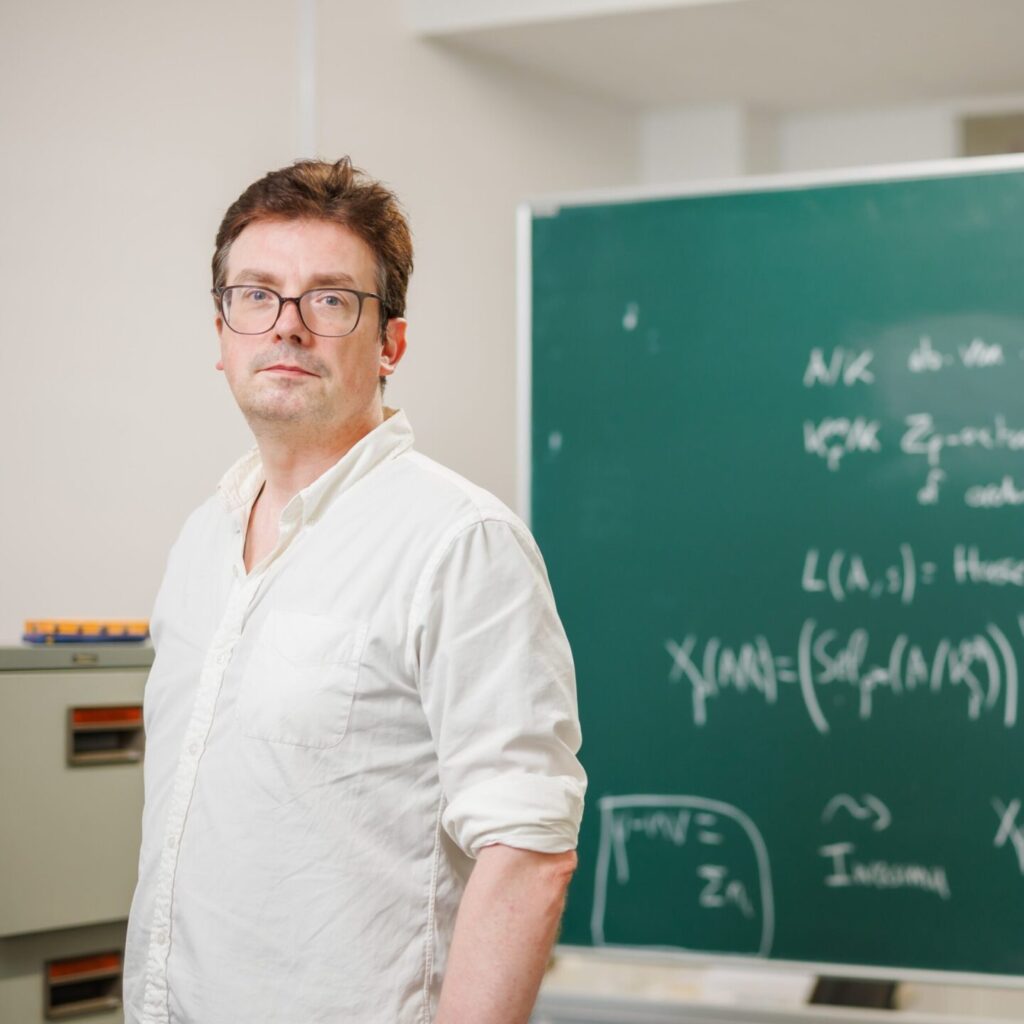
As a specialist in algebraic geometry and number theory, professor Fabien Benoit Trihan of the Faculty of Science and Technology is attempting to answer the deepest questions of mathematicians by using the p-adic zeta function and elliptic curve theory. What is so fascinating about modern mathematics, which connects with topics that are completely different?
The material of everything that surrounds us is composed of individual units called atoms. In the world of numbers, whole numbers are also made up of something equivalent to atoms: prime numbers. The reason for this is because all whole numbers can be produced by multiplying prime numbers together.
Ordering the prime numbers from smallest to largest—2, 3, 5, 7, 11, 13, and so on—no regular pattern can be discerned. However, in 1859 the German mathematician Bernhardt Riemann suggested that, although they seem to be irregular at first glance, prime numbers actually do appear to exhibit order. This observation came to be known as the “Riemann Conjecture.” The conjecture is still unsolved, but if correct, then the amount of prime numbers below a certain number should be able to be calculated with relatively high accuracy.
Unlike real numbers, p-adic numbers hold the key to deciphering prime numbers

In brief, mathematics has several different fields such as number theory, which investigates the qualities of prime numbers and whole numbers; algebra, which deals with equations; analysis, which discusses the limits of functions and convergence; and geometry, which explores the connections between shapes of figures. Despite there being superficial differences, modern mathematics has increasingly shown that there are connections between the different disciplines. For instance, the Riemann zeta function serves as a bridge that connects the seemingly disparate fields of number theory and analysis. The function essentially makes it possible to think about seemingly scattered prime numbers using analytical methodology.
However, the Riemann zeta function is difficult to use on its own, which is why functions similar to Riemann zeta were devised. One of my research topics is one of those, called the p-adic zeta function.
The p-adic zeta function belongs to a world of unique numbers called p-adic numbers. In the world of real numbers, we continue from 0, 1, 2, 3, and so on, gradually increasing in value. But in the world of p-adic numbers, moving towards a prime number “p” moves us closer to 0 such that p2, p3 , p4 and so on progressively move towards 0. There is a big difference in perspective between p-adic numbers and the real numbers we learn about from elementary school, but in fact p-adic numbers and real numbers both include all rational numbers (those that can be expressed as fractional numbers).
By deepening one’s understanding of the p-adic zeta function, I think it can provide a clue to solving the Birch and Swinnerton-Dyer conjecture (BSD). The BSD conjecture asks whether the number of rational points (x and y coordinates both being fractions) passing through an elliptical curve (expressed as y2=x3) can be determined using a function like a zeta-function. Elliptical curves are used in modern virtual currencies and encryption in IC cards, so research on the BSD conjecture is related to cryptography.
Solving problems from a bird’s eye view
I am conducting collaborative research with mathematicians from Japan, France, England, Taiwan, and elsewhere. What I’m particularly good at is solving problems abstractly by using the symmetry behind some mathematical objects as well as the relationships that can be perceived as two sides – their duality. Simply put, my style is to fly into the sky and gaze down on problems from above, much like a bird. On the other hand, there are those amongst our collaborators who prefer to give concrete examples and tackle problems head on. I think that we can have harmonious collaboration by leveraging each others’ strengths,
My aim is to help solve some of the most difficult problems of mathematics through my research on p-adic L-functions and elliptic curves.
The book I recommend
“Séminaire de Géométrie Algébrique du Bois Marie”
by Alexander Grothendieck, Springer-Verlag

This book is a summary of the seminar of a veritable titan of mathematics, Alexander Grothendieck, which he gave to his students. Of the 13 volumes, I have read the 4th one many times since my days as a graduate student. Grothendieck was my mentor’s mentor’s mentor, or as we sometimes say in mathematics circles, “my grand-grand father.”
-
Fabien Benoit Trihan
- Associate Professor
Department of Information and Communication Science
Faculty of Science and Technology
- Associate Professor
-
Fabien Benoit Trihan earned his PhD from the University of Rennes in France in 1996. After completing a few postdoc positions, including one at the University of Tokyo, he entered his first permanent position at the University of Nottingham in the UK. Later, he was appointed Associate Professor at the University of Exeter before joining Sophia University in 2015.
- Department of Information and Communication Science
Interviewed: August 2022